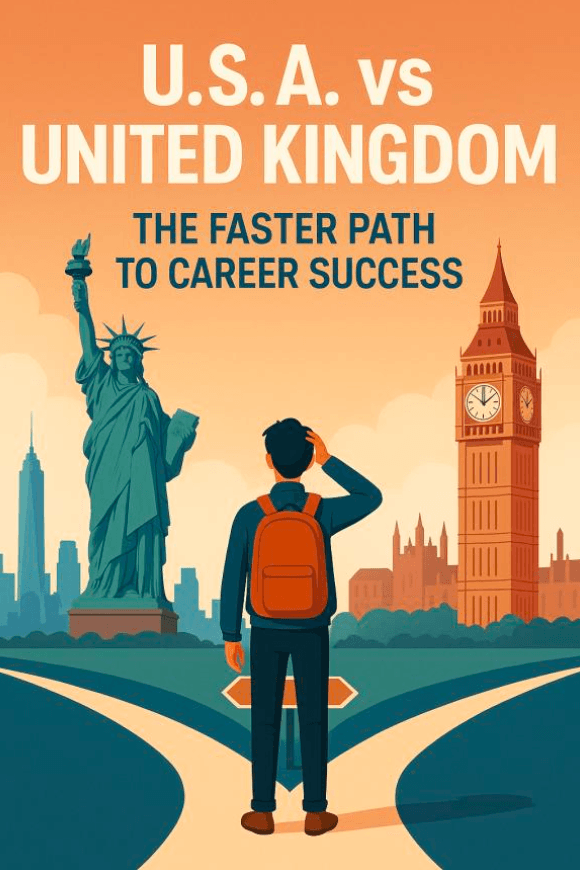Every year, hundreds of thousands of international students face a defining question long before graduation: “Where should I build my career — the United States or the United Kingdom?”
Both nations promise world-class education and access to global employers. But for those who want to work, grow, and settle, the real debate is about speed, stability, and sustainability — which system moves you faster from classroom to career?
This analysis looks beyond perception to measurable realities — job markets, visa structures, salaries, and employer behavior — and how Flashfire is reshaping outcomes through data-driven automation.
Redefining “Career Success” for International Graduates
For an international graduate, success extends beyond the first job. It includes:
- Employability: Finding degree-relevant work fast.
- Visa Flexibility: Sufficient time and options to gain experience.
- Sponsorship Support: Employers willing to invest in visas.
- Financial Return: Compensation that justifies education cost.
- Pathway to Residency: Structured, predictable settlement.
1) Job Market Size and Skill Demand
United States
The U.S. job market is the largest and most skill-hungry globally. BLS projects strong growth (20–30%) in AI, data, cybersecurity, software, healthtech, and clean energy by 2030. Thousands of employers sponsor H‑1B talent annually.
Flashfire’s targeted approach (1,200+ aligned applications per user) drives interview calls within 2–3 weeks on average.
United Kingdom
A globally integrated, service-led economy with strengths in finance, consulting, design, and emerging tech. The 2‑year Graduate Route offers flexibility but doesn’t directly lead to settlement and cannot be extended.
Verdict: Both are strong, but the U.S. offers a broader pool of high-value, degree-aligned roles — especially for STEM/digital fields.
2) Work Authorization: OPT vs Graduate Route
U.S.: OPT (12 months) + STEM OPT (24 months) = up to 3 years. Multiple H‑1B attempts without employment gaps.
U.K.: Graduate Route allows 2 years (3 for PhD) without sponsorship but doesn’t count toward settlement and isn’t renewable.
Verdict: U.S. provides greater time flexibility and continuity for sponsorship attempts.
3) Employer Sponsorship Behavior
U.S.: ~85,000 H‑1B visas annually; approval rates for selected petitions were ~96% (2023). Big sponsors include Amazon, Google, Microsoft, Meta, Deloitte, Intel — plus many mid‑tier firms with mature processes.
U.K.: No lottery; direct Skilled Worker sponsorship — but fewer than ~90,000 licensed sponsors, limiting options, especially among smaller firms.
Verdict: U.S. = larger sponsorship ecosystem. U.K. = simpler rules but smaller sponsor pool.
4) Pathway to Permanent Residency
U.S.: H‑1B → PERM → Green Card. H‑1B can be extended while Green Card is pending, ensuring continuity despite backlogs.
U.K.: ILR after 5 continuous years on Skilled Worker; Graduate Route time doesn’t count. Breaks can reset the clock.
Verdict: U.K. can be faster if sponsorship starts early; U.S. offers steady continuity once on H‑1B.
5) Salary Growth and ROI
U.S.: NACE reports CS entry‑level at ~$90K–$110K; AI/Data/Engineering often $120K+. Tuition ROI often in 2–3 years.
U.K.: Typical graduates earn £30K–£45K; London tech roles ~£55K–£60K. Higher taxes/housing extend break‑even.
Verdict: U.S. offers stronger earning potential and faster ROI, especially in STEM/digital.
6) Innovation Ecosystem and Industry Access
U.S.: SF Bay Area, Boston, Seattle, Austin — deep, cross‑industry ecosystems; nine of the top ten global tech firms headquartered here.
U.K.: London (fintech), Cambridge/Manchester (research/design); strong but smaller market with selective visa programs.
Verdict: U.S. remains the global center for high‑growth, interdisciplinary careers.
7) Work Culture and Professional Growth
U.S.: Fast‑paced, merit‑driven, outcome‑oriented; rapid mobility across roles and industries.
U.K.: Professional, structured, balanced; progression can feel slower in traditional sectors.
Verdict: U.S. accelerates growth; U.K. optimizes balance. Choose based on priorities.
8) The Flashfire Edge: Precision and Acceleration
Across both countries, timing and targeting determine outcomes. Flashfire applies AI to match degrees with sponsor‑ready roles, verify employers, and automate 1,200+ high‑fit applications per month — with full tracking and recruiter analytics.
- Filters by degree relevance and visa category
- Checks employer sponsorship history
- Surfaces fresh openings with higher response likelihood
This transforms the hunt into a structured, data‑driven process — a decisive advantage when every visa year counts.
Comparative Summary
| Parameter | United States | United Kingdom |
|---|---|---|
| Post‑Study Work Period | Up to 3 years (OPT + STEM) | 2 years (Graduate Route) |
| Sponsorship System | Lottery‑based, large‑scale ecosystem | Direct sponsorship, smaller pool |
| Avg Starting Salary (STEM) | $90K–$110K | £35K–£50K |
| Settlement Timeline | 6–8 years (H‑1B + Green Card) | 5 years (Skilled Worker + ILR) |
| Innovation Ecosystem | Deep, cross‑industry, global | Focused on finance and research |
| Work‑Life Balance | Fast‑paced, merit‑driven | Balanced, structured |
| Strategic Advantage | Multiple sponsorship attempts | Simpler rules, shorter window |
Conclusion: The Faster Path Lies West
Both destinations are world‑class. But for speed, scalability, and sustainability, the U.S. system typically wins: longer work authorization, higher salaries, broader sponsor base, and deeper innovation ecosystems.
The U.K. offers an accessible start and balance, yet limited sponsorship networks and shorter timelines can slow long‑term momentum.
With Flashfire streamlining applications, matching degrees to sponsor‑friendly roles, and surfacing real‑time opportunities, international graduates can navigate with precision — and move faster.
Apply smart, not just hard. Start with Flashfire to turn global education into sustainable career outcomes.
